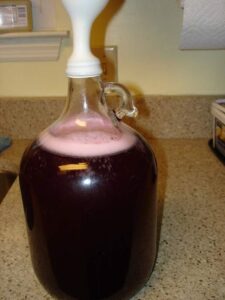
Here’s the full recipe for Homemade Wine using Welch’s Grape juice and frozen blueberries:
Ingredients:
- 1 (12 oz.) can Welch’s Grape juice concentrate, frozen
- 4 cups sugar
- ½ cup water
- 1 packet yeast
- Water (as needed)
- 4 pints frozen blueberries (or any fruit of your choice)
- Filtered water (as needed)
Instructions:
- Thaw out the frozen blueberries and place them in a pot. Add a little filtered water to the pot and cook the blueberries over low heat until they are soft and mushy.
- Transfer the cooked blueberries to a blender and pulse until they form a smooth puree.
- Place the blueberry puree in a piece of cheesecloth and squeeze out as much juice as possible. You should have about 2 1/2 quarts of blueberry juice.
- In a large pot, dissolve the sugar in ½ cup of water over medium heat. Stir until the sugar is completely dissolved.
- In a small bowl, dissolve the yeast in a little warm water according to the package instructions.
- In a gallon jug, combine the Welch’s Grape juice concentrate, dissolved sugar mixture, and dissolved yeast mixture.
- Fill the jug with additional water until it reaches within 1 inch of the top.
- Cover the mouth of the jug with a balloon to allow for gassing during fermentation.
- Store the jug in a cool, dark place and wait for 5 weeks until the fermenting process stops. You may notice the balloon inflating during this time, which indicates fermentation is occurring.
- After 5 weeks, carefully syphon the wine from the jug, taking care not to disturb the sediment at the bottom of the jug. Alternatively, you can filter the wine through a fine mesh sieve or cheesecloth.
- Rebottle the wine in clean, sterilized bottles and cork them tightly.
- Allow the wine to age for at least a few weeks before enjoying. The longer you let it age, the smoother and more flavorful it will become.
- Serve your homemade blueberry wine chilled and enjoy responsibly!
Note: You can experiment with different fruits and juice concentrates to create your own unique flavors of homemade wine. Have fun and enjoy the process!
Certainly! Here are some popular questions and their answers related to Homemade Wine:
- Is it legal to make homemade wine?
- In many countries, it is legal to make homemade wine for personal consumption, but there may be restrictions and regulations regarding the quantity produced, distribution, and sale of homemade wine. It’s important to check local laws and regulations before making homemade wine.
- How long does it take to make homemade wine?
- The time it takes to make homemade wine can vary depending on factors such as the type of wine being made, the fermentation process, and the aging period. Generally, the fermentation process takes several weeks to complete, followed by additional aging time ranging from a few months to several years for optimal flavor development.
- What equipment do I need to make homemade wine?
- To make homemade wine, you’ll need basic equipment such as a fermentation vessel (e.g., glass carboy or food-grade plastic bucket), an airlock, a siphon tube, bottles, corks or caps, and sanitizing solution. Additional equipment such as a hydrometer, thermometer, and wine testing equipment may also be helpful for more precise measurements and monitoring.
- Can I use any type of fruit to make homemade wine?
- Yes, you can use a wide variety of fruits to make homemade wine, including grapes, berries, apples, peaches, plums, and more. Each type of fruit will impart its unique flavor characteristics to the wine, allowing for endless possibilities and experimentation with different fruit combinations.
- How do I know when homemade wine is ready to drink?
- Homemade wine is typically ready to drink after the fermentation process is complete, and it has undergone aging for the desired period. You can taste the wine periodically during the aging process to monitor its flavor development and determine when it has reached the desired level of maturity and balance.
- Can I adjust the sweetness and alcohol content of homemade wine?
- Yes, you can adjust the sweetness and alcohol content of homemade wine by controlling factors such as the amount of sugar added during fermentation, the type of yeast used, and the fermentation temperature. Adding additional sugar before bottling can increase sweetness, while adjusting fermentation conditions can impact alcohol content.
- How should homemade wine be stored?
- Homemade wine should be stored in a cool, dark place away from direct sunlight and temperature fluctuations. Bottles should be stored horizontally to keep the corks moist and sealed properly. Proper storage conditions will help preserve the quality and flavor of the wine over time.
